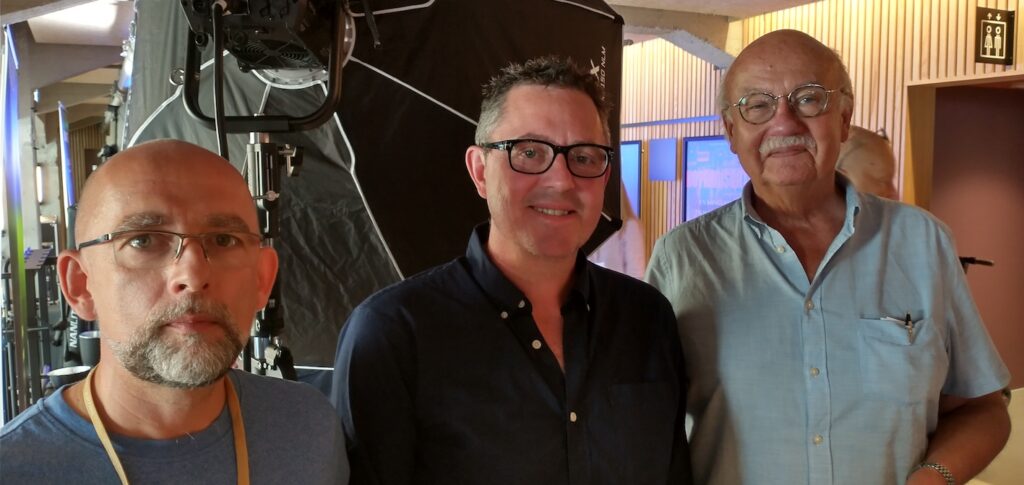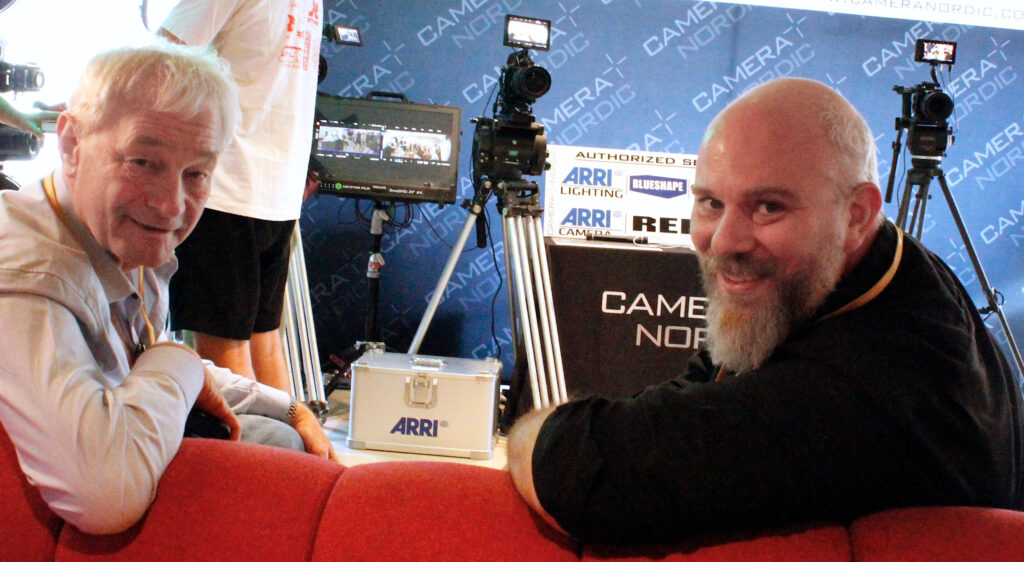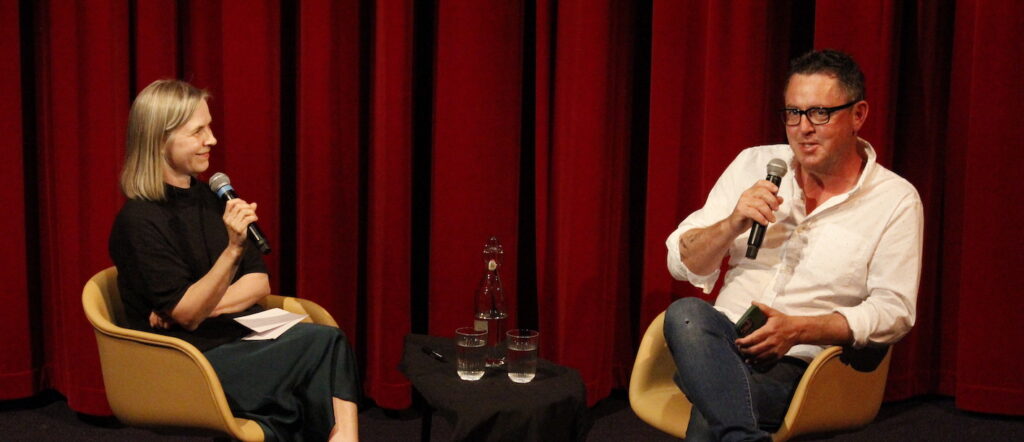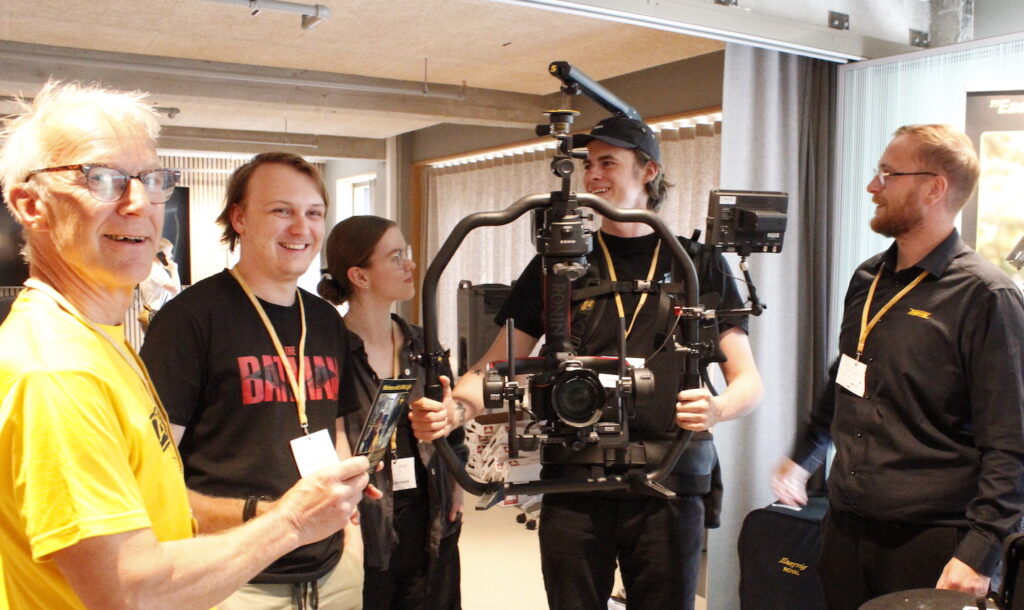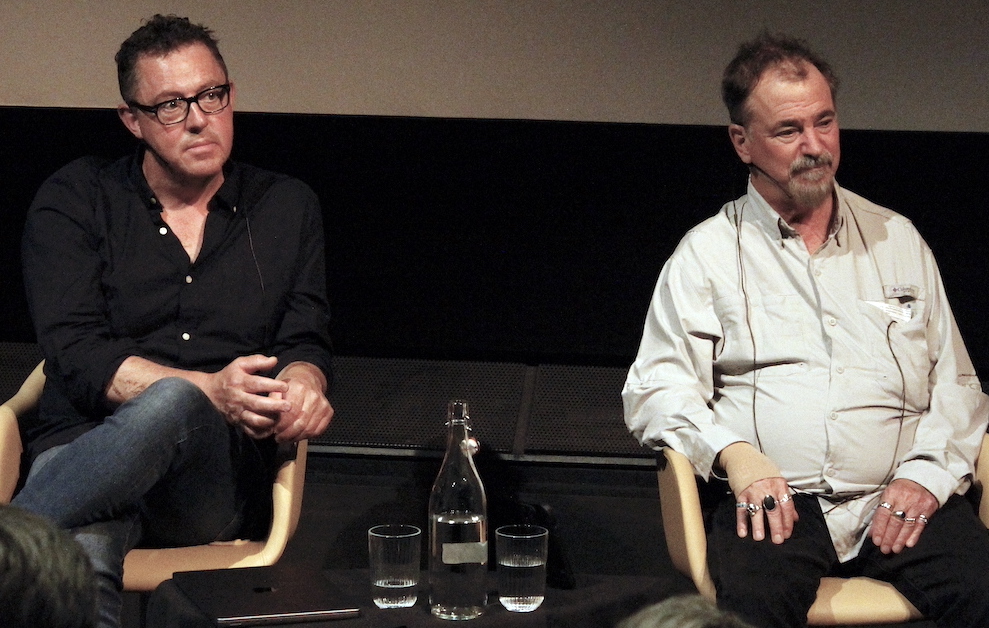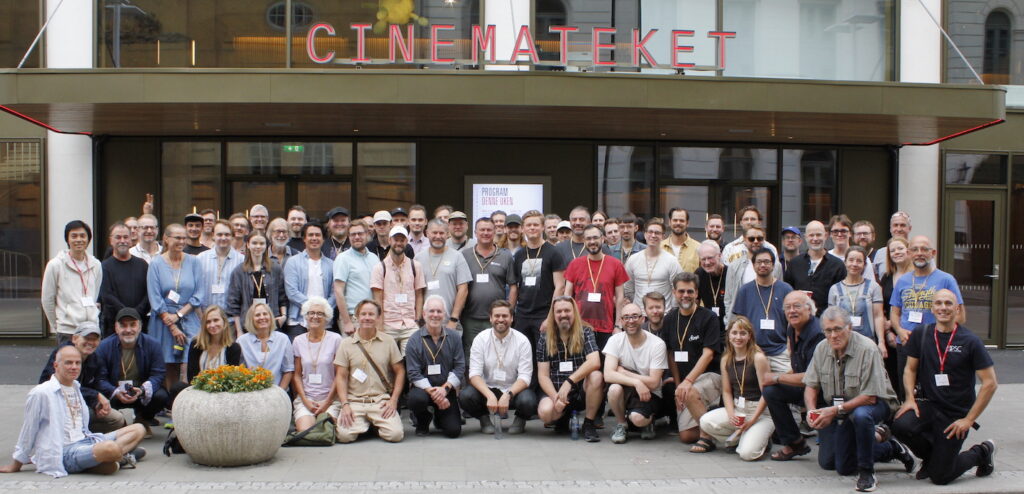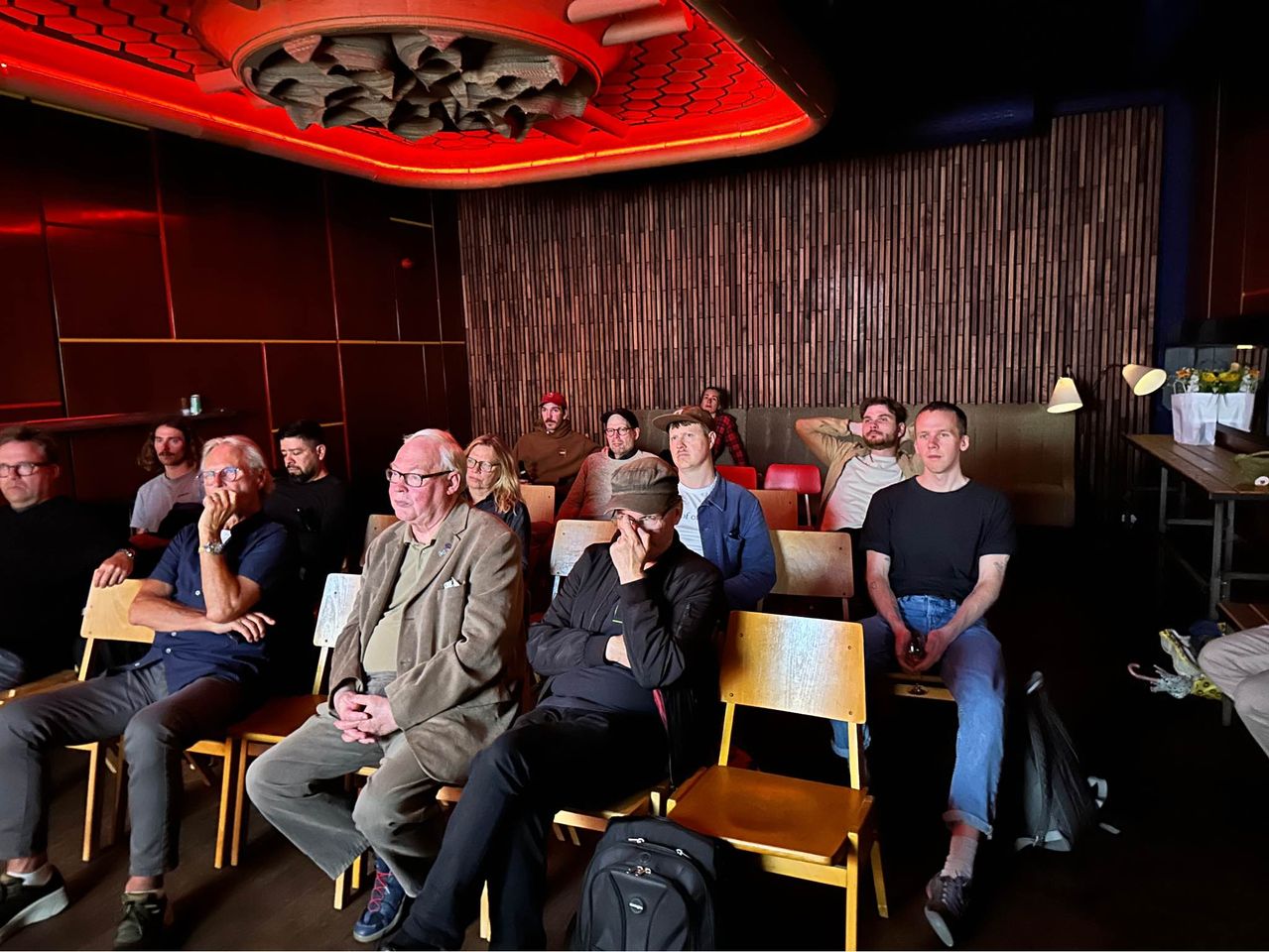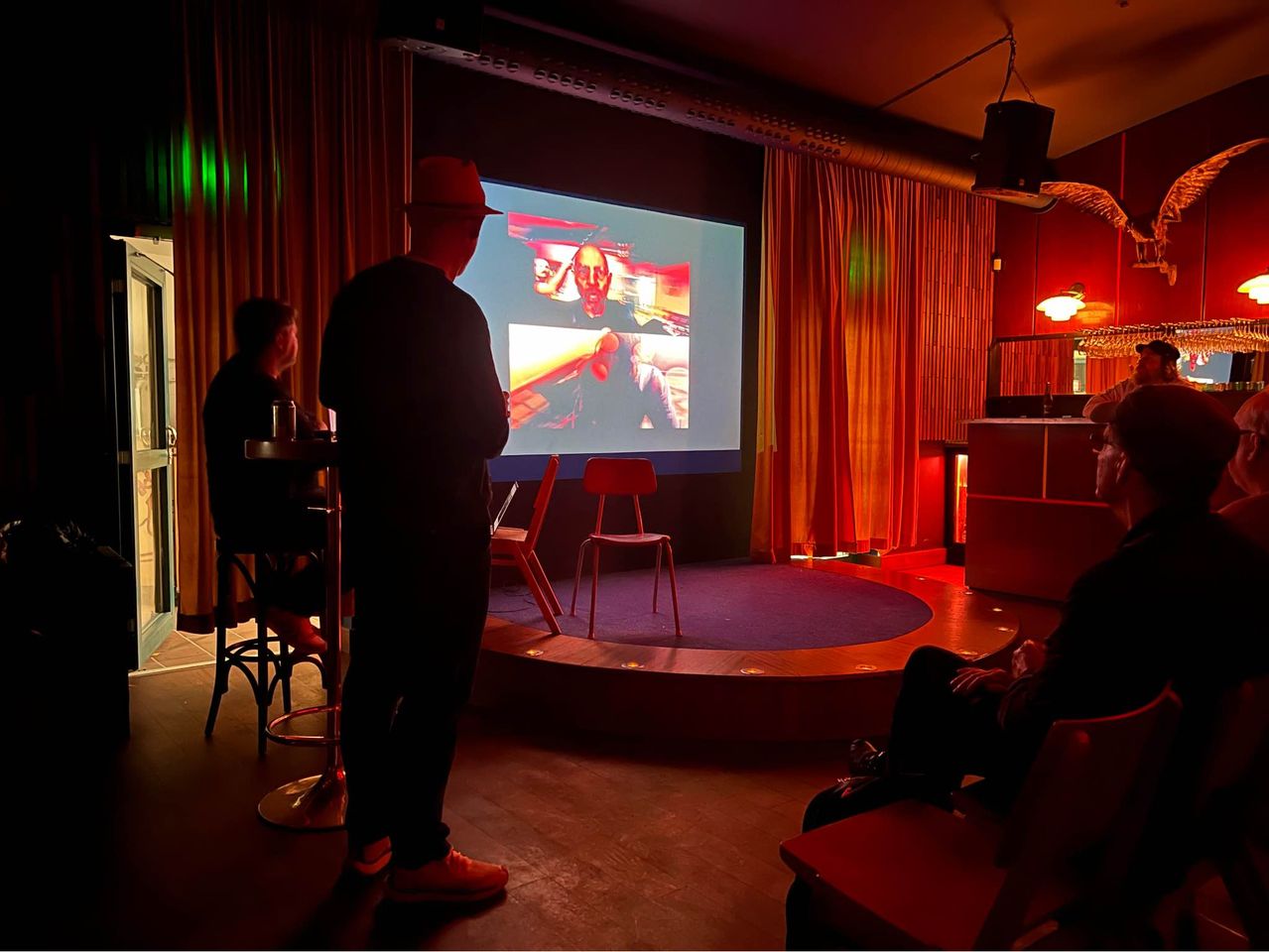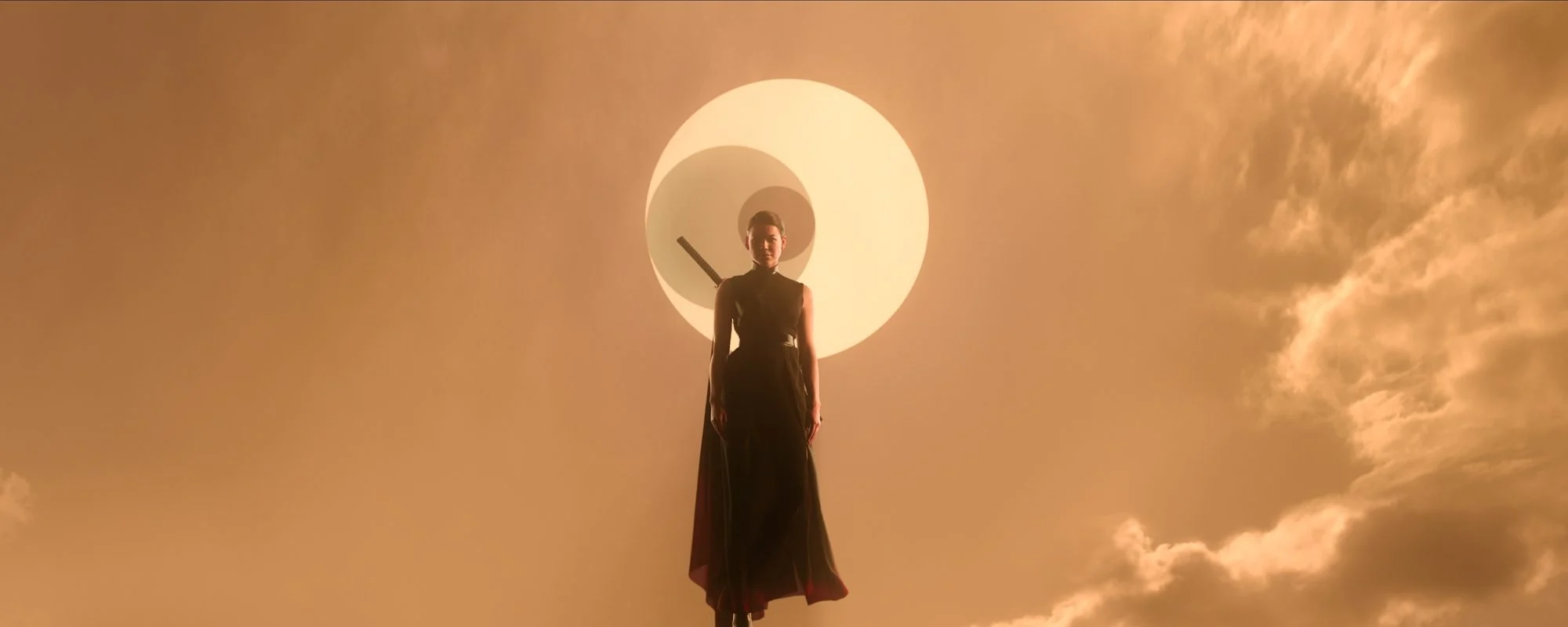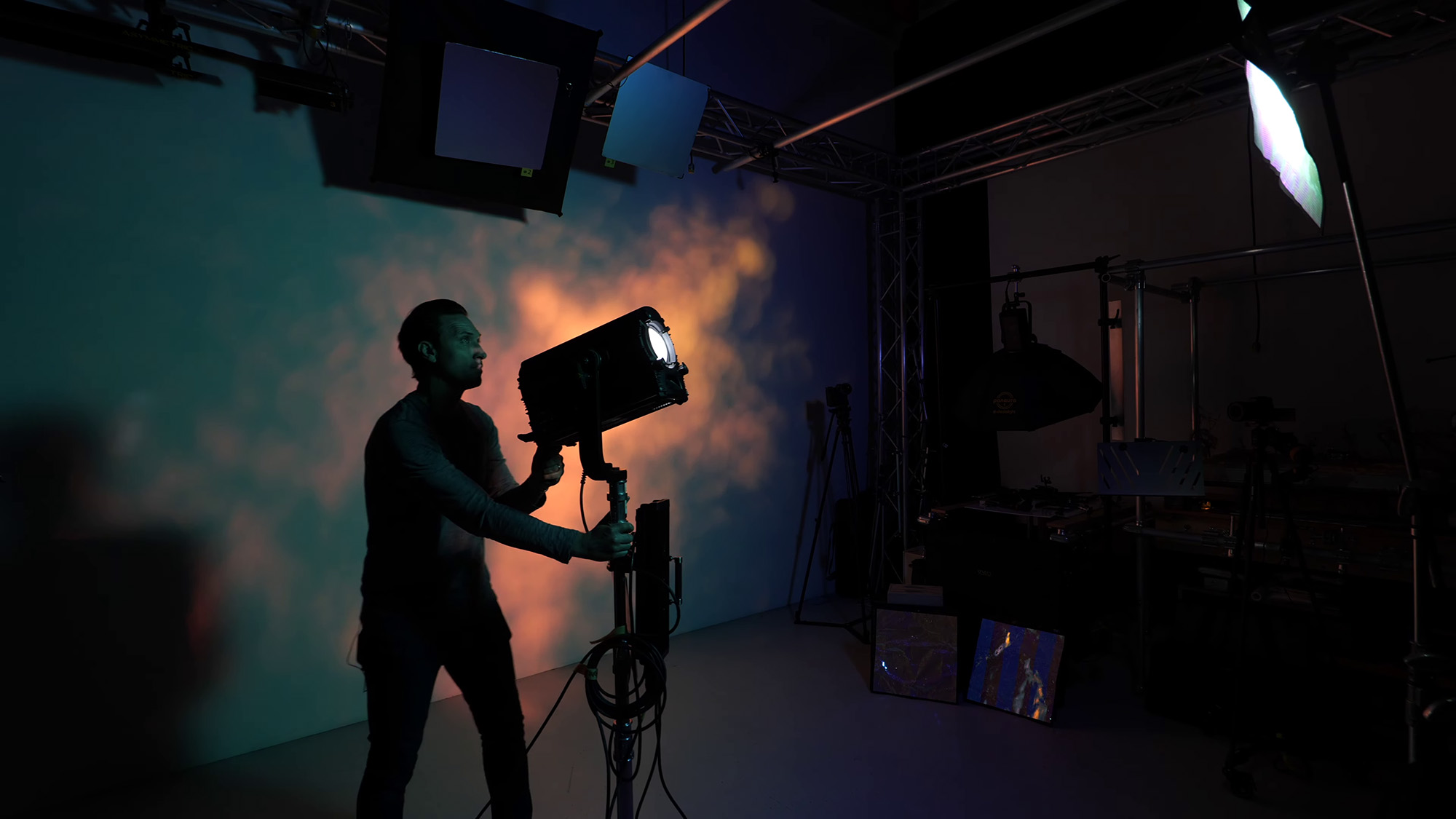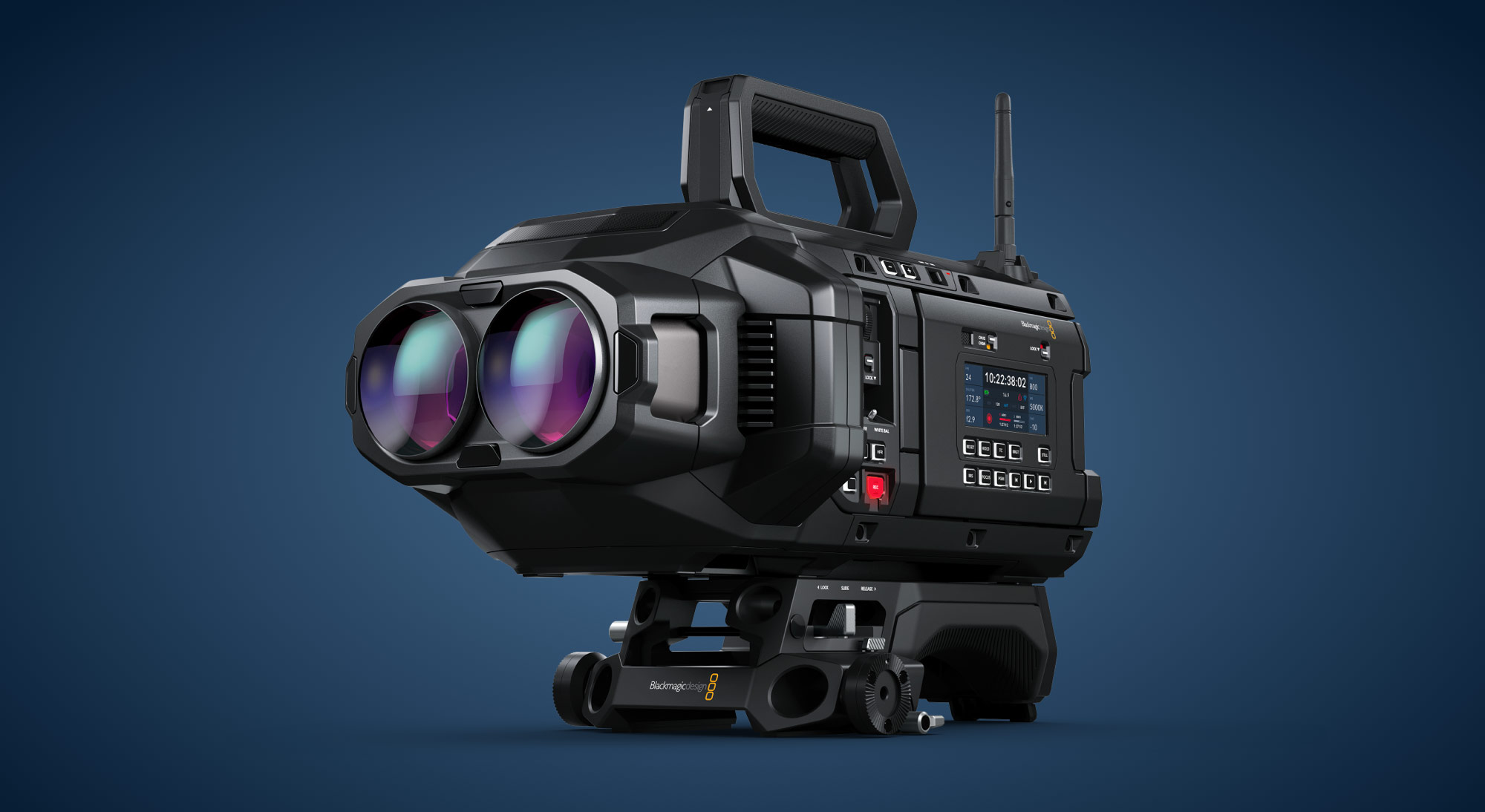Oslo Digital Cinema Conference 2023
The weekend between the 16th and 18th of June at the Norwegian Film Institute in Oslo, the Oslo Digital Cinema Conference (or just the ODCC for short) made its eagerly awaited come back after a regrettable four year hiatus. Under the brilliant supervision and guidance of ODCC’s own Commander-in-Chief, Paul René Roestad FNF, we are treated to no fewer than two spectacular cinematography Master Classes and all in all a whopping 18 presentations! The ODCC is a collaboration between the Norwegian Society of Cinematographers FNF, the Norwegian Film Institute, Nordisk Film & TV Fond as well as the Swedish (FSF) and Danish (DFF) Societies of Cinematographers.
Artur Zurawski PSC, Greig Fraser ASC ACS and Paul René Roestad FNF
As Paul René Roestad opened the proceedings with customary authority, welcoming us all to the ODCC, he was interrupted by a delightful incident: a small child chanting -someone had brought a young child along probably because the daycare center was closed! This brought out smiles and good cheer all over the auditorium -and we’re off! The 8th ODCC is officially up-and-running.
The first lecture on the program, entitled ”Working conditions for cinematographers: National and international challenges” was held by August Falch, a lawyer working for the Norwegian Filmworkers Union NFF. Scandinavian Film Workers have some of the best working conditions in the industry, bar none, and working hours are set to 7,5 hours per day. The ensuing, very constructive, discussion that broke out in the auditorium made it clear that deteriorating working conditions is a big problem world wide in the movie industry, and for instance Polish and South African crews regularly work 12 hour days.
Environmentally friendly filmmaking was a theme throughout the whole weekend, and Alex Berkovic from Dedolight, who is also on the IMAGO Technical Committee, explained how reflected light can be used to considerably reduce the environmental footprint on a production. If you consider bouncing light placed at street level and facing upwards into a third floor window off a reflector as opposed to placing an 18K on a cherrypicker, you get an idea how much can be done to cut down on transportation, energy consumption, etc, with this approach.
And one constantly learns so much at an ODCC… It turns out that the 18K DC-powered arc lights manufactured during world war one and two are among the most perfected light sources ever produced(!) and when you contemplate they were used to detect airplanes at altitudes of five kilometers, you begin to see why. But cost was not an issue when they were produced (it would cost about 200 000 Euros to build one today).
Sony was represented by Daniel Listh and he continued the theme of reducing your environmental footprint with the presentation ”Virtual Production In Camera VFX (ICVFX) and Sustainability”. And of course it goes without saying that shooting in a LED volume in London in stead of sending the whole crew to Brazil to shoot on location will cut down dramatically on carbon dioxide emission. But in fact, there was so much on VP during the ODCC, that I’ve decided to give it it’s own section, see below. Suffice to say, Sony are getting into VP in a big way on the LED panel side of things and they may be the game changer here, since they’re aiming to provide reflection free LED panels, and reflections are a problem the way things are right now.
Daniel Listh pointed out that one of many advantages of working in a LED volume is it means you can have 20 hours of twilight… There is a laugh from audience and Daniel Listh quickly corrects himself, ”oh, sorry; 7,5 hours of twilight!” 🙂
Cooke Optics Chairman Kees van Oostrum ASC in conversation with Steve Calavitis in the Camera Nordic booth
In a presentation called ”The digital Chromogen” we learn from Daniele Siragusano from Filmlight that there is no such thing as ”No Look” to shot material -it is an impossibility! Daniele explains how FilmLight’s new software Chromogen can be used to create novel looks. An interesting point which he makes in his speech, and one too seldom contemplated, is that film itself always evolved throughout cinema history: films shot in the 1910s were wildly different from those in the late 1970s for instance. So why shouldn’t digital also evolve from where we are right now in terms of cinematic look?
More fascinating stuff from the IMAGO Technical Committee was delivered by messieurs Philippe Ros AFC, Dave Stump ASC and Alex Berkovic under the headline ”Photon Path. How a digital image is processed”. They made it clear to us in the audience that it’s a jungle out there, people aren’t using concepts like ”sensel”, ”pixel”, ”resolution” etc the way the words should be used and we keep getting offered 4K, 6K, etc equipment which may have considerably lower resolution than that in the final analysis.
Next on the program was social gathering and drinks in the foyer outside the cinema. It’s a tough job, but we all volunteered and queued up in the bar, mingled and -big surprise- talked some more about movies!
Hege Jaer interviewing Greig Fraser ASC ACS prior to the ”Rogue One” screening
The auditorium was packed to capacity for the Friday evening screening of Gareth Edwards’ 2016 Star Wars spinoff ”Rogue One”. Greig Fraser, ASC ACS, was very capably interviewed by Hege Jaer before the movie started, and those of us who both saw ”Rogue One” and the Saturday Master Class with Greig Fraser got a very comprehensive presentation indeed of the man and his work, as Hege Jaer also gave us some insight into Fraser’s early career and what inspired him to become a cinematographer. The spirit was cheerful and festive in the cinema and Greig even took a selfie with the entire audience cheering and waving their hands at him, sending it to Gareth Edwards, the director of ”Rogue One”.
Saturday began with a textbook example of VP ’done right’ as John Christian Rosenlund FNF, Dave Stump ASC, Rob Peyton from ARRI Virtual Solutions and Markus Helminen, VFX Supervisor, explained how the LED volume technology had been used during the making of the film “A Rare Grand Alignment”. It’s the story of three American school children who are marooned in a cable car gondola in the Norwegian mountains.
They had a decent budget on this project, about 5 million Euros, but nowhere near enough money if you wanted to shoot the story ”the Hollywood way”, so everywhere along the way, the filmmakers had to find ways of doing things cheaper and more efficiently than what had been the case if they’d had a massive budget. As a case in point, Rosenlund would’ve loved to have the set chilled down to the point where you would see the actors’ breath in the air, but the cost to do this was ”hilarious” according to Rosenlund, so they settled for getting it down to about 5° C, which was an affordable option, and along with the ability to always see the alpine surroundings ’for real’ on set, also helped the young actors to stay in character and deliver solid performances.
Philippe Ros AFC then entered the stage, to enlighten us on the subject of ”LED : All you want to know”. And I thought I knew what there was to know about LED lights… Well guess again! Philippe Ros is a walking encyclopedia of knowledge and I think very few audience members didn’t learn something new about LED lights here.
Johan Hellsten and Pontus Jonsson, extreme left and right, with the next generation of filmmakers in the Easyrig booth
After lunch we are then treated to ”6 Color Light Engine RGBACL and latest trends in LED lighting. What´s next in LED lighting?” a presentation held by serial entrepreneur and tech wizard Morten Hjerde, founder of and CTO at Rift Labs.
And then it’s time for a Master Class in which recent Academy Award winner for best Cinematography (for ”Dune” which premiered in 2021) Greig Fraser ASC ACS recalls his experiences in a conversation with Dave Stump ASC. Greig has also delivered stunning imagery for a number of high-profile projects over the last few years, like “The Mandalorian”, “Star Wars: Rougue One”, “The Batman” and “Zero Dark Thirty”.
Fraser has just finished shooting ”Dune Part 2” in Hungary, Abu Dhabi and Jordan, and he cracks the audience up when he recalls how (Greig having just spent 2 1/2 months in the Jordanian desert) his wife recently suggested they should go to Egypt for a holiday vacation!
The discussion touched on a number of subjects ranging from directors’ visual preferences to whether digital is the right fit for all projects or not. Here are a few highlights.
”There is a risk that if the audience knows beforehand with what technology something was shot”, fraser notes, ”that can get in the way of their connecting with the story. It becomes about the technique rather than just getting yourself immersed in the story. Myself I would rather not know how something was shot before I see it”.
”One of the first films I shot”, Fraser continues, ”was finished with printer lights and a physical 35mm print. Then there was the era of the DI finish and then we moved into a completely digital workflow. But now things have become a little too perfect. With film there would be mistakes like a hair in the gate and other artifacts. I find that that can sometimes be really helpful for an audience to lose themselves into a picture”.
”Super-sharp, faultless digital, and film with all it’s quirks and artifacts… Neither of them is right or wrong, and there is going to be a script and a director’s vision for all of those things”, Stump and Fraser agree.
Greig Fraser ASC ACS interviewed by Dave Stump ASC at Saturday’s Masterclass
When revving up for ”Dune” a few years ago, ”we tested Imax, we tested 35mm film”, Fraser recalls. ”We tested all the formats and found that what we liked best was digital but with a film-out”.
One flashback sequence in ’Dune’ shot in extreme slow motion on the Phantom camera ”really stood out from all the other material and felt very digital and so we opted to try shooting it out on 35, 16 and even 8 mm film to add some grain. You can even go to 1mm film, I have done that. I think there is a strong argument for going back to film. It’s not for everything. But for some projects I feel going back to film is really helpful. We did the same process on ’the Batman’ but went further and even had a 35mm print done. The finished film is about 60% print , 30% film negative and 10% digital. We could do this surprisingly quickly because we came up with a number of rules. Close-ups would usually be the print, but wide shots would feel too soft on the print, so then we went with the negative or digital”.
”Directors have such different opinions on subjects such as lens sharpness etc”, Fraser muses. ”One Director wants it sharp edge to edge and top to bottom, then someone like Matt Reeves on ’the Batman’ wants the edges of the frame to be so fuzzy you can’t make out what’s there”.
After a coffee break, it’s then time for four presentations in a row.
Greig Fraser explained that all of Dune was recorded back out on film in order to arrive at the final look for the project, and as this is a technique very much in demand at Cinelab Film & Digital in the UK, there was a nice segue into this next presentation: ”The importance of full service film labs in a digital World”. Cinelab are represented here at the ODCC by CEO Adrian Bull as well as Christian Martinsen, who gave the actual lecture.
Among the things we learned were ”never ever carry exposed negative as hand bagage at an airport. New x-ray machines are being installed soon that are even more powerful and will fog film”. The way to go is to use Fed Ex or a similar contractor to ship your exposed footage from wherever you’re shooting to the lab -and preferably Cinelab, then.
Audience favorite and tech wizard Dave Stump ASC is back then on the podium and in a presentation called ”Extended reality in Real Time” delivers vital information about LED pixel pitch, viewing angles, moiré etc.
Bojana Andric SAS, with Elen Lotman ESC on computer screen
”Diversity and inclusion – where are we today?” was presented by Elen Lotman ESC and Bojana Andric SAS. The stated mission of this IMAGO committee is to one day make itself redundant, and Andric and Lotman gave a captivating and entertaining resumé of work performed by the committee to this end during the last few years.
Rounding off the Saturday line-up of presentations, Rob Payton from ARRI Solutions in a lecture called ”What is cooking at ARRI?” went through exactly what the title implies! ARRI are heavily into Extended Reality and have a standing state of the art LED volume in London which is used for actual productions as well as for research and educational purposes.
True to tradition, the Saturday program ends with a wonderful party at nearby Storyline Studios, where in a relaxed setting the guests are treated to all the beer, wine and pizza they can handle
Waiting for the bus to take us back after Saturday night’s party. But wait… What’s that big white thing in the background..?
A short Virtual Production Summary.
The Sony, John-Christian Rosenlund, Greig Fraser and Dave Stump presentations all extensively discussed Virtual Production, so I thought it would be a good idea to wrangle it all together in one place here. While everyone agrees VP offers sensational advantages compared to traditional green screen work, particularly when dealing with transparent or shiny objects, there were also many concerns and warnings brought forward that the filmmaking community are now embracing LED volumes as a ”magic bullet” to solve all production problems.
Numerous challenges have been identified ranging from difficulties recording good production sound (large parallell surfaces inside the volume), to insufficient knowledge about the technique among those in charge of entire productions; the old adage ”we’ll fix it in post” no longer applies: in a LED volume you ”bake in” the image once and for all the moment you turn the cameras!
In many ways, with LED volumes we’re back to the mindset of the days of film when you chose your negative, your exposure and your printing lights and then that was it: the look of the images were ”baked in” into the negative and very little could be done to change it afterwards.
Also, the signal out from the camera is the only visual reference you should focus on when doing VP work, the images on the LED walls may look horrible to the naked eye, but what matters is what it looks like when recorded. Also, to get good results from VP work, the cinematographer needs to be in charge of recording the footage. Production management or the VFX department telling the DoP what to do and how, will not lead to happy results. Also, at the present time LED walls should NOT be relied on as a light source illuminating whatever it is you are filming, because the output is weak and the color characteristics are terrible.
As tradition will have it, the early Sunday presentations all start out with the audience somewhat thinned out and strangely quiet and reflective… But the ODCC continues like clockwork. A presentation celebrating one of the foremost cinematographers of all time, entitled ”The Nordic Light. Sven Nykvist 100 years”, held by yours truly, is well received by the audience and then it’s time for yet another eagerly awaited Master Class, this time featuring Eben Bolter BSC, capably moderated by Trond Tønder FNF and focussing on the cinematography for the production of “The last of us” for HBO. This is the story of adapting a video game into an acclaimed tv series.
Eben Bolter has moved through the cinematographic learning curve remarkably quickly, and with the energy and attitude of an athlete running the 100 metres dash! Early on in his career, and eager to get as much experience as possible, he at one time shot 51 short films in one year! That has to be some kind of unofficial record.
But he confesses that since he managed to early on become so experienced in such a short time, Bolter felt an insecurity on his early jobs, ”I always tried to cover up what those who hired me mustn’t discover, I felt I had to keep them from finding me out”, he remembers.
Eben Bolter BSC and Trond Tønder FNF
